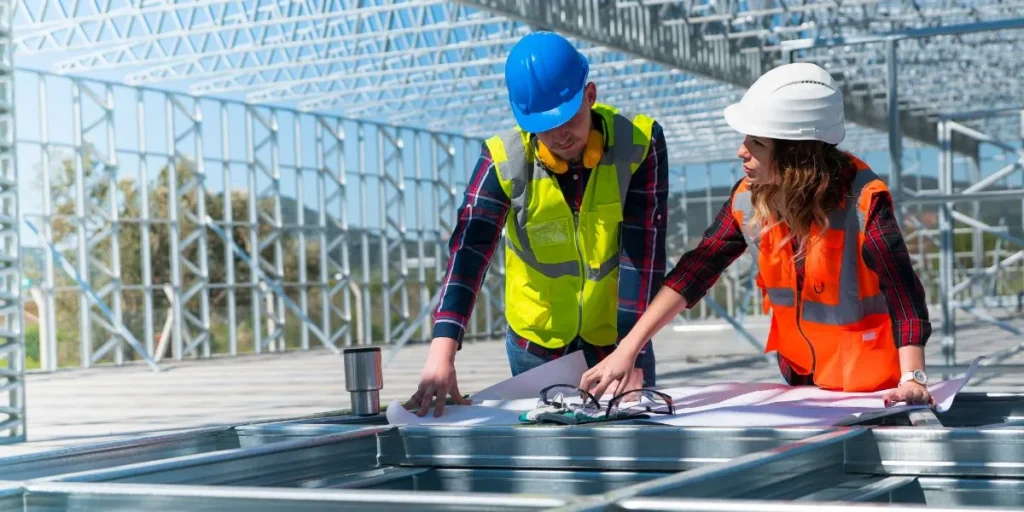“In an industry long defined by manual labor, what does it mean to embrace innovation without losing the human touch?”
Construction work was earlier done only by hand and was done using old methods. But now, with the advent of technology, the roles of people doing construction work worldwide are changing. As machines and AI tools are being used, new skills are required on construction sites, and working methods and safety are also improving.
Today we will see how the construction work is changing due to the adoption of new technology and what opportunities and challenges it poses.
The Rise of Technology in Construction

Nowadays, new tools are being used more and more in the construction of houses and buildings, such as robots, drones, and computer programs. All these things help you see the work, make it better, and do it easier. From this perspective, the type of people working as well as the way of working is changing. As reported by McKinsey, the report says that the use of this technology has increased by more than 30% in the last few years, which is a huge change for the industry.
How Technology Is Changing Labor Roles
- Automation and AI: automated, repetitive tasks will be reduced, and workers will shift into technical and supervisory roles. AI in construction projects will assess project efficiency and predict schedules.
- Skills Upgrade: Technology adoption will be critical, and the demand for tech-savvy workers will be in machine operation, data analysis, and problem-solving. Construction workers need to be trained in digital skills, and technology-enabled equipment needs to be managed.
- Improved safety: wearable technology and drones will improve safety, monitor real-time conditions, and reduce risk; OSHA believes that the implementation of wearables will make industrial accidents less likely to occur successfully, job sites safer, and workers more efficient.
The Benefits of Embracing Technology in Construction Labor
Efficiency
Increasing the efficiency of technical workflows, reducing downtime, and automating time-consuming tasks can improve project timelines and quality. According to the Harvard Business Review, construction projects are completed 20–30% faster using automation than traditional methods.
Cost savings
Automating work can reduce costs by reducing excess labor and improving resource allocation. High-tech machines enable higher accuracy and reduce material waste. The World Economic Forum has stated that construction companies can reduce project costs by 25% by utilizing high-tech solutions.
Enhanced Quality and Precision
Laser-guided machines and advanced tools provide accurate measurements, minimize errors, and improve construction quality; according to the MIT Technology Review, precision technology has improved structural quality by 40% in each field.
Know More: Senior Living Operators, Architects Lean on Renovations, Technology to Bolster Wellness
Challenges in Technology Adoption for Construction Labor
- Skills Gap: Technology adoption is a major challenge. Workers need to be retrained to install and operate advanced equipment. Construction company executives can bridge the gap by investing in refresher training programs conducted by the company.
- Implementation costs: The initial costs of purchasing and implementing technology can be high. Firms can offset this by phasing in the technology over time.
- Resistance to change: Workers resist adopting technology because it threatens their job security. Companies can smooth the transition by holding workshops and providing ongoing support.
🔧 Premier Construction Software recently partnered with Lumber to transform workforce management in #construction! 🏗️ Together, they streamline payroll, HR, & real-time labor data for enhanced efficiency, job costing, and project success. 📊 #ConstructionTech – Learn more 👉… pic.twitter.com/XHlEdkjGdM
— Construction Links Network (@constructca) October 22, 2024
Preparing for the Future of Construction Labor
Training Programs
By investing in training programs, companies can increase their competitiveness by effectively managing the skills of their workers. The National Association of Home Builders (NAHB) believes that training programs are critical and wants to see technology integrated smoothly.
Collaboration with Tech Experts
When technology firms partner with construction companies, they increase the speed of technology implementation as well as ongoing support and expertise. Deloitte’s strategic partnerships increase the speed and efficiency of technology implementation.
Future Outlook
Construction labor will be redefined by technology. Analysts predict that the role of construction labor will evolve further, with technological skills becoming essential for field workers. The World Economic Forum estimates that 50% of construction labor roles will require advanced digital technology.
Conclusion
In conclusion, technology is transforming the construction industry, redefining labor roles, and also improving safety and efficiency. There are challenges, such as skill gaps and costs, but by embracing new technologies, construction companies can move towards a sustainable and effective future.
As the industry progresses, new opportunities will emerge for those who adapt and reskill, and this will set the stage for a tech-enabled construction era.



